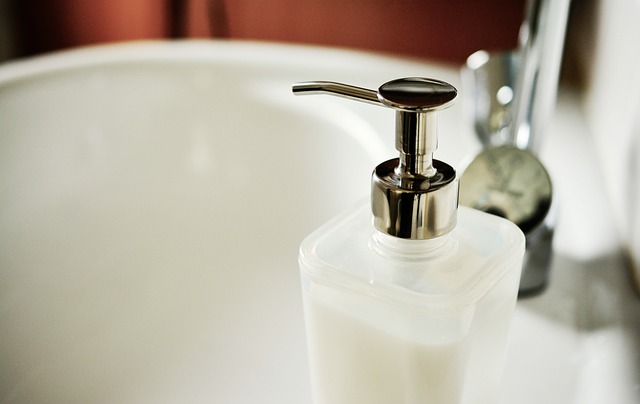So, you want to keep your house clean and organized but don’t know where to start? Don’t worry, we’ve got you covered! In this article, we will guide you step-by-step on how to develop an effective cleaning routine for your household. No more feeling overwhelmed or unsure of what needs to be done. With our easy-to-follow guide, you’ll be able to create a cleaning schedule that will keep your home spotless and your mind at ease.
Curious to learn more? Well, in this article, we will break down the process of creating an effective cleaning schedule for your home. We will cover everything from prioritizing tasks and setting realistic goals to creating a schedule that works for you. By following our step-by-step guide, you’ll be able to establish a routine that will save you time and energy in the long run. Say goodbye to last-minute cleaning frenzies and hello to a clean and organized home. So, let’s get started and transform your cleaning routine today!

Planning Your Cleaning Routine
Cleaning your home can feel like a daunting task, especially if you don’t have a clear plan in place. That’s why it’s important to develop an effective cleaning routine that works for you and your household. By doing so, you can ensure that your home stays clean and organized year-round. In this step-by-step guide, we’ll walk you through the process of creating a cleaning schedule that will help you maintain a tidy and welcoming home.
Identify your cleaning goals
The first step in creating a cleaning routine is to identify your cleaning goals. Take a moment to think about what you hope to achieve through your cleaning efforts. Do you want to maintain a clean and organized home? Are you looking to reduce allergens and create a healthier living environment? Once you have a clear idea of your goals, you can tailor your cleaning routine to address these specific areas.
Determine your cleaning frequency
Next, you’ll need to determine how often you want to clean each area of your home. Some tasks, such as dusting and vacuuming, may need to be done weekly or even daily. Other tasks, such as deep cleaning the bathroom or washing windows, can be done less frequently, such as monthly or seasonally. By establishing a cleaning frequency for each task, you can create a schedule that is realistic and manageable for you.
Consider your time constraints
Before finalizing your cleaning routine, it’s important to consider your time constraints. Take a realistic look at your schedule and determine how much time you can realistically allocate to cleaning each day or week. If you have a busy schedule, you may need to break up your cleaning tasks into smaller increments or enlist the help of other household members. By considering your time constraints, you can create a cleaning routine that is both effective and practical for your lifestyle.
Organizing Your Cleaning Supplies
Now that you have identified your cleaning goals and determined your cleaning frequency, it’s time to organize your cleaning supplies. Having a well-organized collection of cleaning products and tools will make your cleaning routine more efficient and enjoyable. Here’s how you can get started:
Create a cleaning supplies checklist
Begin by taking inventory of your current cleaning supplies. Make a checklist of the products and tools you need to effectively clean your home. This may include all-purpose cleaners, glass cleaners, disinfectant wipes, scrub brushes, and microfiber cloths. By creating a checklist, you can ensure that you have all the necessary supplies on hand before you start your cleaning routine.
Organize your cleaning products
Once you have your checklist, it’s time to organize your cleaning products. Consider grouping similar items together, such as all-purpose cleaners in one area and bathroom cleaners in another. This will make it easier to locate the products you need when it’s time to clean. You may also want to consider storing your cleaning products in a caddy or bin for easy transport from one room to another.
Designate storage areas
In addition to organizing your cleaning products, it’s important to designate specific storage areas for your cleaning supplies. This will help you keep your cleaning routine efficient and maintain a clutter-free home. Consider using cabinets, shelves, or storage bins to keep your cleaning supplies neatly organized and easily accessible. By designating storage areas, you can streamline your cleaning process and save time searching for the products you need.
Creating a Room-by-Room Cleaning Checklist
Now that you have your cleaning supplies organized, it’s time to create a room-by-room cleaning checklist. Breaking down your cleaning tasks by specific areas of your home will help you stay organized and ensure that no task is overlooked. Here’s how you can create a comprehensive cleaning checklist:
Break down your home into specific areas
Start by breaking down your home into specific areas, such as the kitchen, bathroom, living room, and bedrooms. This will help you focus on one area at a time and prevent you from feeling overwhelmed by the entire cleaning process. By dividing your home into specific areas, you can tackle each room more efficiently and effectively.
List tasks for each room
Once you have identified the areas of your home, make a list of the cleaning tasks that need to be done in each room. For example, in the kitchen, you may need to wipe down countertops, clean the appliances, mop the floor, and empty the trash. In the bathroom, you may need to clean the toilet, scrub the bathtub, and wipe down the mirrors. By listing tasks for each room, you can ensure that no area is overlooked during your cleaning routine.
Prioritize tasks based on importance
After listing the tasks for each room, it’s important to prioritize them based on importance. Determine which tasks need to be done daily, weekly, or monthly, and rank them accordingly. For example, tasks like sweeping the floors or making the beds may be a daily priority, while tasks like washing windows or deep cleaning the carpets may be a monthly priority. By prioritizing tasks, you can create a cleaning schedule that is realistic and manageable for your lifestyle.
Establishing a Daily Cleaning Routine
To maintain a clean and organized home, it’s important to establish a daily cleaning routine. Here’s how you can get started:
Identify daily cleaning tasks
Begin by identifying the cleaning tasks that need to be done on a daily basis. These tasks may include making the beds, doing a quick tidy up, wiping down surfaces, and sweeping or vacuuming high-traffic areas. By establishing daily cleaning tasks, you can ensure that your home stays clean and clutter-free throughout the week.
Allocate time for each task
Once you have identified your daily cleaning tasks, allocate a specific amount of time for each task. This will help you stay on track and prevent cleaning from becoming an overwhelming or time-consuming task. Set aside a block of time each day to focus solely on your cleaning tasks, and use a timer or stopwatch if necessary to stay on schedule.
Create a cleaning schedule
Finally, create a cleaning schedule that outlines when you will complete your daily cleaning tasks. This can be a simple chart or calendar that breaks down your tasks by day or time. By creating a cleaning schedule, you can ensure that your cleaning routine becomes a regular habit rather than an overwhelming chore. Stick to your schedule as closely as possible, making adjustments as needed based on your daily activities and commitments.

Implementing a Weekly Cleaning Routine
In addition to your daily cleaning routine, it’s important to implement a weekly cleaning routine. This will help you tackle deeper cleaning tasks that may not be done on a daily basis. Here’s how you can create a weekly cleaning routine:
Assign weekly tasks for different days
To make your weekly cleaning routine more manageable, assign specific tasks to different days of the week. For example, you may designate Mondays for dusting and vacuuming, Tuesdays for cleaning bathrooms, Wednesdays for washing windows and mirrors, and so on. By spreading out your cleaning tasks throughout the week, you can prevent them from piling up and becoming overwhelming.
Create a weekly cleaning schedule
Once you have assigned tasks to different days, create a weekly cleaning schedule that outlines when you will complete each task. This can be a simple chart or calendar that breaks down your cleaning tasks by day or time. By creating a weekly cleaning schedule, you can ensure that your cleaning routine remains consistent and that all tasks are completed regularly.
Allocate ample time for thorough cleaning
When implementing your weekly cleaning routine, it’s important to allocate ample time for thorough cleaning. This means allowing enough time to deep clean each area of your home so that it is left spotless and refreshed. Avoid rushing through your cleaning tasks and instead, focus on quality over speed. By allocating ample time for thorough cleaning, you can ensure that your home remains clean and inviting for you and your family.
Incorporating Monthly and Seasonal Cleaning Tasks
In addition to your daily and weekly cleaning routines, it’s important to incorporate monthly and seasonal cleaning tasks into your schedule. Here’s how you can do this effectively:
Identify monthly and seasonal tasks
Start by identifying the monthly and seasonal tasks that need to be done in your home. These tasks may include cleaning out and organizing closets, deep cleaning kitchen appliances, washing curtains or blinds, or decluttering and donating unused items. By identifying these tasks, you can ensure that they are not forgotten or overlooked during your regular cleaning routine.
Allocate specific days or weeks for these tasks
Once you have identified your monthly and seasonal tasks, allocate specific days or weeks in your cleaning schedule for these tasks. This will help you stay organized and prevent these tasks from becoming neglected over time. For example, you may designate the first week of each month for deep cleaning tasks, or dedicate the spring and fall seasons for thorough cleaning and maintenance.
Consider deep cleaning and maintenance
When incorporating monthly and seasonal cleaning tasks, it’s important to include deep cleaning and maintenance in your routine. This may involve tasks such as carpet cleaning, upholstery cleaning, or air duct cleaning. By incorporating these tasks into your cleaning routine, you can ensure that your home remains clean, healthy, and free of allergens and pollutants.

Developing Good Cleaning Habits
To maintain an effective cleaning routine, it’s important to develop good cleaning habits. Here are some tips to help you establish and maintain these habits:
Incorporate regular tidying into your routine
In addition to your scheduled cleaning tasks, make it a habit to incorporate regular tidying into your daily routine. This includes simple tasks such as putting away toys, wiping down surfaces, and decluttering as you go throughout the day. By making tidying a regular habit, you can prevent messes from piling up and ensure that your home remains clean and organized.
Clean as you go throughout the day
Incorporate the habit of cleaning as you go throughout the day. For example, after cooking a meal, clean up the kitchen immediately instead of letting dishes and messes pile up. This will save you time and effort in the long run and prevent cleaning tasks from becoming overwhelming. By cleaning as you go, you can maintain a clean and tidy home with minimal effort.
Teach cleaning habits to other household members
If you live with others, it’s important to involve them in your cleaning routine and teach them good cleaning habits. Assign age-appropriate tasks to each household member and encourage them to take responsibility for their own spaces and belongings. By involving others in the cleaning process, you can maintain a clean and organized home together.
Addressing Special Cleaning Challenges
Despite your best efforts, you may encounter special cleaning challenges in your home. This could include tough stains, stubborn messes, or specific cleaning issues that require additional attention. Here’s how you can address these challenges effectively:
Troubleshoot common cleaning issues
Start by troubleshooting common cleaning issues that you may encounter. This could include issues such as removing stains from carpets or upholstery, getting rid of odors, or cleaning difficult-to-reach areas. Research common solutions for these issues and try different methods until you find one that works best for your specific situation.
Find solutions for tough stains or messes
If you encounter tough stains or messes that are difficult to remove, don’t panic. There are often specialized cleaning products and techniques that can help. For example, there are stain removers specifically formulated for different types of stains, such as red wine or grease. By finding the right solutions for tough stains or messes, you can ensure that your home stays clean and inviting.
Research effective cleaning methods
When facing special cleaning challenges, it’s important to conduct research and stay informed about effective cleaning methods. There are countless online resources, books, and articles that offer advice and solutions for various cleaning issues. By staying educated and up-to-date, you can develop the knowledge and skills necessary to tackle any cleaning challenge that comes your way.
Maintaining a Clean and Organized Home
To maintain a clean and organized home, it’s important to establish simple daily organizing habits. Here’s how you can do this effectively:
Establish simple daily organizing habits
Start by establishing simple daily organizing habits. This could include tasks such as putting items back in their designated places after use, sorting through mail and paperwork regularly, and making it a habit to declutter as you go throughout the day. By incorporating these habits into your daily routine, you can prevent clutter from accumulating and maintain an organized home.
Regularly declutter and donate unused items
In addition to daily organizing habits, it’s important to regularly declutter and donate unused items. Take time each month to go through your belongings and identify items that are no longer needed or used. Donate these items to charitable organizations or host a garage sale to create a clutter-free space. Regularly decluttering will not only help you maintain an organized home but can also create a more peaceful and stress-free environment.
Create systems for maintaining cleanliness
To maintain cleanliness in your home, create systems that work for you and your household. For example, designate specific areas for commonly used items, implement a “one in, one out” rule for new purchases, or establish a daily cleaning routine. By creating systems that suit your lifestyle, you can easily maintain a clean and organized home without feeling overwhelmed.
Conclusion
In conclusion, developing an effective cleaning routine is vital for maintaining a clean and organized household. By identifying your cleaning goals, determining your cleaning frequency, and considering your time constraints, you can create a cleaning routine that works for you. By organizing your cleaning supplies, creating a room-by-room cleaning checklist, and establishing daily and weekly cleaning routines, you can ensure that your home remains clean and inviting year-round. By incorporating monthly and seasonal cleaning tasks, developing good cleaning habits, and addressing special cleaning challenges, you can maintain a clean and organized home that you and your family can enjoy. So, what are you waiting for? Start implementing your own cleaning routine today and enjoy the benefits of a clean and organized home.
